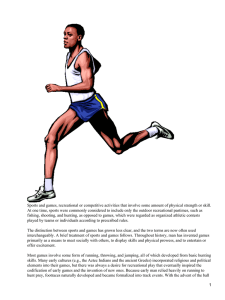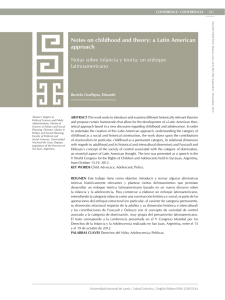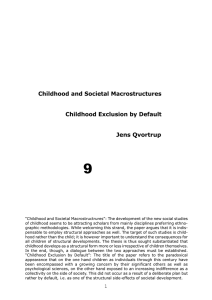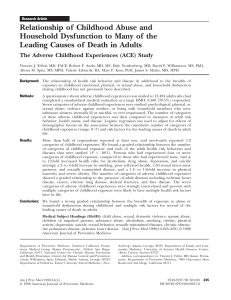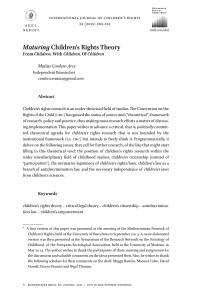GAMES AND THE CONTRADICTIONS OF CHILDHOOD Juergen
Anuncio
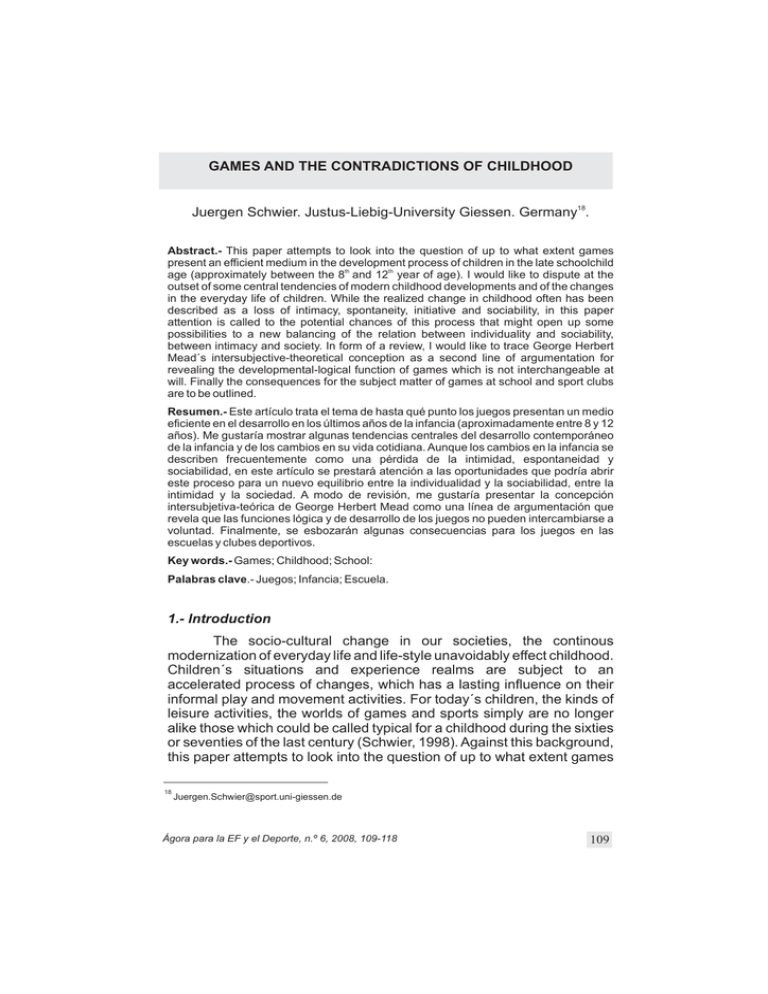
GAMES AND THE CONTRADICTIONS OF CHILDHOOD Juergen Schwier. Justus-Liebig-University Giessen. Germany18. Abstract.- This paper attempts to look into the question of up to what extent games present an efficient medium in the development process of children in the late schoolchild th th age (approximately between the 8 and 12 year of age). I would like to dispute at the outset of some central tendencies of modern childhood developments and of the changes in the everyday life of children. While the realized change in childhood often has been described as a loss of intimacy, spontaneity, initiative and sociability, in this paper attention is called to the potential chances of this process that might open up some possibilities to a new balancing of the relation between individuality and sociability, between intimacy and society. In form of a review, I would like to trace George Herbert Mead´s intersubjective-theoretical conception as a second line of argumentation for revealing the developmental-logical function of games which is not interchangeable at will. Finally the consequences for the subject matter of games at school and sport clubs are to be outlined. Resumen.- Este artículo trata el tema de hasta qué punto los juegos presentan un medio eficiente en el desarrollo en los últimos años de la infancia (aproximadamente entre 8 y 12 años). Me gustaría mostrar algunas tendencias centrales del desarrollo contemporáneo de la infancia y de los cambios en su vida cotidiana. Aunque los cambios en la infancia se describen frecuentemente como una pérdida de la intimidad, espontaneidad y sociabilidad, en este artículo se prestará atención a las oportunidades que podría abrir este proceso para un nuevo equilibrio entre la individualidad y la sociabilidad, entre la intimidad y la sociedad. A modo de revisión, me gustaría presentar la concepción intersubjetiva-teórica de George Herbert Mead como una línea de argumentación que revela que las funciones lógica y de desarrollo de los juegos no pueden intercambiarse a voluntad. Finalmente, se esbozarán algunas consecuencias para los juegos en las escuelas y clubes deportivos. Key words.- Games; Childhood; School: Palabras clave.- Juegos; Infancia; Escuela. 1.- Introduction The socio-cultural change in our societies, the continous modernization of everyday life and life-style unavoidably effect childhood. Children´s situations and experience realms are subject to an accelerated process of changes, which has a lasting influence on their informal play and movement activities. For today´s children, the kinds of leisure activities, the worlds of games and sports simply are no longer alike those which could be called typical for a childhood during the sixties or seventies of the last century (Schwier, 1998). Against this background, this paper attempts to look into the question of up to what extent games 18 [email protected] Ágora para la EF y el Deporte, n.º 6, 2008, 109-118 109 present an efficient medium in the development process of children. However, the issue is not expanded on the entire period of childhood, but is limited to the late schoolchild age (approximately between the 8th and 12th year of age).On the basis of recent findings of German childhood research, I would like to dispute at the outset of some central tendencies of modern childhood developments and of the changes in the everyday life of children. While the realized change in childhood often has been described as a loss of intimacy, spontaneity, initiative and sociability, in this paper attention is called to the potential chances of this process. As today´s children must cope with social complexity, media, regulations, strangeness, a broad variety, and social time handicaps; this phenomenon might open up some possibilities to a new balancing of the relation between individuality and sociability, between intimacy and society. In form of a review, I would like to trace George Herbert Mead´s intersubjective-theoretical conception as a second line of argumentation for revealing the developmental-logical function of games which is not interchangeable at will. Finally the consequences for the subject matter of games at school and sport clubs are to be outlined. 2.- Childhood and Sociocultural Change When working on the hardly manageable variety of scientific publications to the issue “childhood in change”, I have now and then recalled a statement given by Baudrillard. The child, says Baudrillard (1992, 194), is the adult´s fate “who denies him irretrievably, bearing with the grace of the one who does not have a will of his own.”. However, it has not been so rare that I encountered some self-appointed advocates for children in literature. And these advocates seem to deny on their part that children have a possibility to be childlike nowadays. And they report on nothing but “small grown-ups”, mostly sitting in front of PC or TV screens, managing cleverly devised time-tables, and in all, being rather inactive and showing a considerable readiness for violence more and more often. Here it strikes you that for this general labelling of an entire generation as just consumer children or mass media´s children or even hurried children (Elkind 1988), monster children, children of fear and children without childhood, there often appear to be basical some educational constructs with regard to a good and successful childhood. The mythologicalexessive point of reference for this is the idea of a white, male street childhood as of the fifties or sixties of the last century. The suspicion may arize that some authors have formed a romantical fantasy from their own childhood memories and a longing for a childhood which is not suitable for the real life of today´s adolescents. Those who hastily proclaim the “disappearance of childhood” (Postman, 1994) without having an empirical correlate or those who complain in an undifferentiated manner 110 about the “end of growing up freely” do not only run the risk of going for a neoconservative culture criticism, but they reveal as well a missing confidence in the adolescent´s energy for opposition and their ability for co-constructive self-socialisation. What scholars like Neil Postman ignore “ is the fact that popular culture is not only a site of enormous contradiction but also a site of negotiations for kids, one of few places where they can speak for themselves, produce alternative public spheres, and represent their own interests” (Giroux, 2000, 13). I do not at all want to deny that for more than two decades there has been a serious change in living spaces and situations for children all over Europe, which in particular fields might become critical with regard to the problems of being a child. In Germany numerous studies meanwhile have traced in detail tendencies of letting the media take control of children´s life and they reveal, that children become domesticated. They talk about an isolation of child-typical life spaces, an increase in preconceived programs for children, a necessity for goal-directed planning of the daily routine or of a sportification of childhood (Büchner, 1990; Zeiher & Zeiher, 1998). The effects of these phenomena on children´s informal playing activities and their motor behaviour have been debated by Schmidt (1998) who points out the changes in space experience and the decrease of personal initiatives. In this context it has to be taken into consideration that not all children are effected to the same extent and in a comparable manner by these development trends. There is not just one childhood but there are differing childhoods. It is not to be ignored furthermore that the changes in childhood are faced as well with the continuances of a family-Childhood, a peer-group-childhood or a school-childhood. In contrast to conditions of growing-up in the sixties of the last century, today´s childhoods probably are more clearly arranged, of a greater variety, more instable and ambivalent. A characteristic feature of (post-)modern children´s everyday life may well be the simultaneous coexistence of individualized and collectively bound daily routines and leisure activities (Zeiher & Zeiher, 1998), the bringing about of which is essentially prestructured by the respective socio-ecological life conditions and processed by the initiative of the adolescent concerned. Among others, especially those adolescents stand for this relative new form of individualized everyday life of children, who commute between isolated, atomized leisure places and have to plan and coordinate their schedules, who seclude for hours to computers or TV sets, who make their appointments by (mobile) phone preferring a twopersons contact and start leisure careers in sports or music. 111 Collectively bound leisure activities turn out to be performed by , for example, skaters who recapture the pedestrian zones of the cities (Schwier, 1998, pp. 39-65). And there are these girls and boys who recently almost daily play streetball and soccer at those areas of our University Sports Department which are open to the public. Zeiher & Zeiher (1991) interpret both pattern types of children´s leisure activities as a result of an intensified separation between the world of children and that of the adults, i.e. as the result of a polarization of the everyday world. While on the one hand special worlds for children are arising, which set usability schedules (e.g. theme parks, multimedia productions, adventure grounds, sports offers from clubs or commercial agencies), the rest of the everyday world is formed in a high degree for adults´ activities and offers rarely any possibilities for children. Such an analysis, however, can hardly integrated the subversive activities of skaters. And besides that, in my opinion this analysis apparently needs supplementing also with regard to the individualization of children´s day-to-day-life. Children´s everyday life still is not exclusively determined by media culture influences, social time handicaps and standardized places. Büchner (1990, pp. 82-91) has drawn attention to four changes in the childhood life stages and these changes are directly connected with this process. First, the rising generation in Germany becomes independent at an earlier stage because in the scope of a trend to an “informalization of social interaction” (Büchner, 1990, 83). There is a moderation of family bindings, a liberalization of education styles and a decrease in conformous behaviour expectations within the families. The state of being relatively independent of one´s parents is in addition supported by the family´s giving some part of their social control to leisure activities. Second, under the influence of a diversification of life styles, an erosion of social conventions and traditional values, definitely “normal” biographies for special life stages are decreasing. Apparently the same goes for childhood: More and more the child alone is expected to make up his mind for/to decide over and over again on particular variations of his biography and whether to choose them in this way or in another one. The prevailing orientation to the values of self-actualization suggests already for children that they should demonstrate individuality by making decisions on how to use their leisure time (Büchner, 1990, 85-86). Third, the above-mentioned isolation of childhood life spaces might make compound the formation of stable friendships more difficult and promote social distance. These relations which are established at various leisure places are rather short-lived, superficial and noncommittal. The necessity of actively giving concern to a not-homogeneous life space may contribute as well to an expansion of children´s autonomy (Zeiher, 1989, 188). 112 Fourth, a recent trend shows that often an early onset of leisure careers gains a marked biographical relevance. In the course of an expanding sportification of childhood, it becomes an integral part in childhood culture to attend organized sports activities. In some respects, sports careers are exemplary to the individualization of childhood. The sports system concerns an early sportification, the development of a person-related profile of interests and skills as well as the demonstration of the individual capacity for achievement and assertiveness. The individualization of modern childhood is basically contradictory. On the one hand, adolescents are compelled to become independent without receiving any preparation for that. Thus, individualization brings about the danger of an early isolation, a development of social distance or the danger to favour self-related strategies and “to declare the freedom of the most powerful as a norm” (Büchner, 1990, 93). On the other hand, this process of change – leaving more and more possibilities to children for cooperation in determinating the contents of their actions and to dispose independently of their time – opens up some chances for self-regulated and self-responsible actions. Individualization of childhood can as well mean a profit on personal freedom from the institutions which are concerned about socializing. Mainly, when individualization sets on so early adolescents need some possibilities for the development of their selves on the basis of normative action models. If the current postulate of the self-realization is not to become a narcissistic straitjacket, if children are to find a balance between individuality and sociality, then they need a norm-regulated practice which proceeds in solidarity with the others. Games do offer such a practice. 3.- Games in the Process of Social Development The age between 8 and 12 years appears to be a open period for acquiring games. An adaptive-constructive involvement with games and their original affordances is supported, among other things, by the cognitive and interactive developmental process of this stage. With reference to George Herbert Mead´s theoretical concept, in the following it shall be made clear that games in this stage of age on the other hand can act as a medium and a motor of developmental change as well. For Mead (1973, 194) “in the life of the child the game represents the passage from taking the role of others in play to the organized part that is essential to self-consciousness in the full sense of the term.” The synthetization and organization of the various roles the players have to take and the necessary orientation of one´s own behaviour during the play to the normative anticipations correspond to social-cognitive development tasks of this stage. Thus it is supposed that the acts in games not only are 113 regulated by external controls, but can also transform and expand internal structures in late schoolchild age. Following Mead (1973, 276pp.), the formation of interaction competence and identity is accompanied by overcoming egocentrism and decentralization of the child´s social perspective. In games the individual has to involve the organized reactions of his society – the “generalized other” – into his actions. The organized structure of the society thus virtually reflects in the identity of the individual. Mead (1973, pp. 240-253) assumed that there can be no personal identity without the “generalized other”. Only the specifically human ability of role taking opens up the possibility of individuation through socialization: “Just by making the assertion that he is taking the attitude of the person concerned with his behaviour, he will become his own object. Only in taking the roles of the others, we have been in a situation of retrieving on our own. (…) We must be others first, in order to become our own selves” (Mead, 1980, 318, 327). In his educational works Mead (1980, pp. 419; 1983, pp. 352) pointed out that education and learning should be in relation to those social practices which in the ideal case foster the development of interactive competences and the formation of identity. In this connection for Mead (1980, 525) the game is a self-determined principle of the development and an informal didactic phenomenon. He differentiates between the two forms “play” and “game”, which can be assigned to the two stages of role taking. The developmental-logical function of childhood play is the preparation ot role taking by conquering a world of independent social objects and the acquiring of roles which can be experienced concretely. The performing ability to anticipate the reactions of the concrete playmates significates the passage to “game”. Games stimulate the development of role identity, because the actor has to integrate those expectations of his team-mates and opponents which are addressed to him into his action in differing positions and in various figurations. He has to disintegrate his intersubjective responses from the concrete-situative action bindings. And he must have the attitude of all other persons concerned in himself: “Thus in a society group like a sports team just this team is the generalized other” (Mead, 1973, 196). The soccer player who has the ball for instance must take the role of the defender who is pressing him (orientation to the counterplayers), he has to know what sort of pass his team-mates expect (orientation to the team), he has to go without taken the ball with his hands even in contested situations, and furthermore he has to take into consideration that a pass to a player who is offside is not possible (orientation to the rules of the game). The child experiences the existence and the function of a generalized role system, the importance of this conventional frame of action for the intersubjective relations of the actors 114 and the efficiency of the rules for a durable cooperation virtually of oneself in sports games. In the context of the game he or she can develop the ability to differentiate between the own identity and that of the others. The child only plays the one role, however, simultaneously he understands the roles of the others and takes all the possibilities of their behaviour into consideration in order to react according to the situation and the norms. Thus the child gains the qualification for the achievement and coordination of game acts on the basis of socially determined rules and role patterns in being active and while taking the organized attitude of the team for the intersubjective tasks and problems which this team has to face. In a word: The child acquires this qualification at first in and through the game itself. The player can evoke as an attacker the entire repertoire of behaviour possibilities of the defender or he can as the goalkeeper take the perspective of the scorer. This standardization of behaviour expectancies enables the child to design his own identity. The actor is aware of the generalized attitudes, however, he cannot predict in what way he will react. He cannot know whether his actions will be successful or whether he will commit a game-decisive mistake. The child who interprets his game actions from the view of the generalized other thus will simultaneously be aware of his own perspective which can be differentiated from all others. The person who is able to participate with competence in sports games is socialized because of bearing the generalized other in himself. His games act is the response to this organized attitude. The development impulses originating from the games become distinct if one assumes following Mead and Kohlberg & Mayer (1981) that the individuation is prepared through social integration in this period. Through the medium of games the adolescent can pick out as central themes those conflicts (such as for example, the integration of subjective drives into the acquirement of the role taking) which arize in the process of structuring a role identity and a conventional moral judgement. Thus he can, starting from a playful manner, at first test the designed generalized other as a method for the solution of intersubjective problems and contradictions. That is why sports games are not at all a kind of luxury in children´s life, rather can they be a motor for the structuring of one´s selfexperience, self-conciousness, self-distance, and self-control. 4.- Consequences for Game Education I do not want to assert that the total of the risks and ambivalences of being a child in our times could be abolished by a comprehensive support of games. The individualization of childhood and the change of 115 life-styles produce a requirement for orientation which certainly is not to be mastered only through the social praxis of sports games. Rather, I would like to put the matter to the question of how sports games should be initiated and directed in the current social situation. In this connection it appears appropriate to demand first of all from ourselves, i.e. the sports educationalists, more confidence in the basic principles of sports and less nostalgia for lost play world. Even with ethnologists having noticed a proceeding devastation of social relations and sociologists write on exploding demands of an ego-society, sports educationalists should furthermore try to get an arrangement for sports opportunities enabling adolescents to look for and to find an orientation for their activities in company with peers. Presupposing that game and movement activities reveal a downward trend in comparison with that of the fifties or sixties of the last century at least in a quantitative manner, and assuming that the access to sports games in Germany takes place more and more via sports clubs nowadays, Schmidt (1998, pp. 217-263) has pointed out some practical consequences for the physical education. Schmidts´s proposals, which I share to a large extent, can be bundled up and pointed in order to gain two basical strategies. The first strategy is aimed to the development of game spaces for children and to a (re-) activation of self-organized game communities. Such a (re-) activation could on the one hand be supported by physical education in school and sport in clubs if teachers and coaches would be willing lo leave sports halls and fields more frequently, in order to look for suitable game spaces. And they should do this in company with the children who are entrusted to them and within the everyday world of these children. On the other hand, free spaces belonging to schools should be accessible to the public even beyond scheduled meetings. The second strategy consists in my opinion of a radical change in the training for children in sports institutions. The sportification of childhood as it is performed by the organized sports system, parents or culture industry and the early specializing involved in it, lead to the effect that children “receive physical training before they know how to play on their own initiative” (Schmidt, 1998, 135). Furthermore, already in childhood, the practice of games in Germany is not kept overt and without consequences, but at the service of sports careers, it becomes a part of fighting for assertion in the field of social inequalities. My plea is to attempt an aquirement of games in clubs in a newly structured fashion. Sports clubs should create supportive conditions for children´s games and therefore should informalize the formal structure of organized sports activities. However, these conditions are not to restrict already from the 116 beginning children´s multi-dimensional and co-constructive access to these phenomena in order to be at the service of the sport system. If sport clubs want to be a place for social play culture, they have to furnish children with the behaviour scope for playing on their own initiatives. And they have to dispense with offering preconceived solutions for all the conflicts occurring. The game practices in the clubs should ideal-typically allow individual activities and simultaneously arrange some ruleorientated social intimacy. The subject matter is to enable the adolescents to gain intensive, multifarious and socializing game experience which might possibly sensitize them to recognize that the other one is that person “who allows me not to perpetuate myself without end” (Baudrillard, 1992, 200). In this context it is to be investigated up to what extent league games for children from 6- to 10 years of age are desireable from the educational standpoint. 5.- References BAUDRILLARD, J. (1992). Die Transparenz des Bösen. Ein Essay über extreme Phänomene. Berlin : Merve. (first published: Baudrillard, J. (1990). La Transparence du Mal. Essai sur les phénomènes extrêmes. Paris : Editions Galilée). BÜCHNER, P. (1990). Aufwachsen in den 80er Jahren. In P. Büchner, H. Krüger & L. Chisholm (Eds.), Kindheit und Jugend im interkulturellen Vergleich (pp. 79-93). Opladen : Leske & Budrich. ELKIND, D. (1988). The Hurried Child. Reading : Addison-Wesley. GIROUX, H. A. (2000). Stealing Innocence. Corporate Culture´s War on Children. New York : Palgrave. KOHLBERG, L. & MAYER, R. (1981). Development as the Aim of Education : The Dewey View. In L. Kohlberg, Essays on Moral Development. Vol. I (pp. 49-96). San Francisco : Harper & Row. MEAD, G. H. (1973). Geist, Identität und Gesellschaft. Frankfurt/Main : Suhrkamp. (first published: Mead, G.H. (1934). Mind, Self and Society. Chicago : University of Chicago Press) MEAD, G. H. (1980). Gesammelte Aufsätze. Bd. 1. Frankfurt/Main : Suhrkamp. MEAD, G. H. (1983). Gesammelte Aufsätze. Bd. 2. Frankfurt/Main : Suhrkamp. POSTMAN, N. (1994). The Disappearance of Childhood. New York : Vintage Books. 117 SCHMIDT, W. (1998). Sportpädagogik des Kindesalters. Hamburg : Czwalina. SCHWIER, J. (1998). Spiele des Körpers. Jugendsport zwischen Cyberspace und Streetstyle. Hamburg : Czwalina. ZEIHER, H. (1989). Die vielen Räume der Kinder. In U. Preuss-Lausitz (Ed.), Kriegskinder, Konsumkinder, Krisenkinder (pp. 176-195). Weinheim : Beltz. ZEIHER, H. & ZEIHER, H.J. (1991). Wie Kinderalltage zustande kommen. In Ch. Berg (Ed.), Kinderwelten (pp. 242-269). Frankfurt/Main : Suhrkamp. ZEIHER, H. & ZEIHER, H.J. (1998). Orte und Zeiten der Kinder. Weinheim: Beltz. 118



